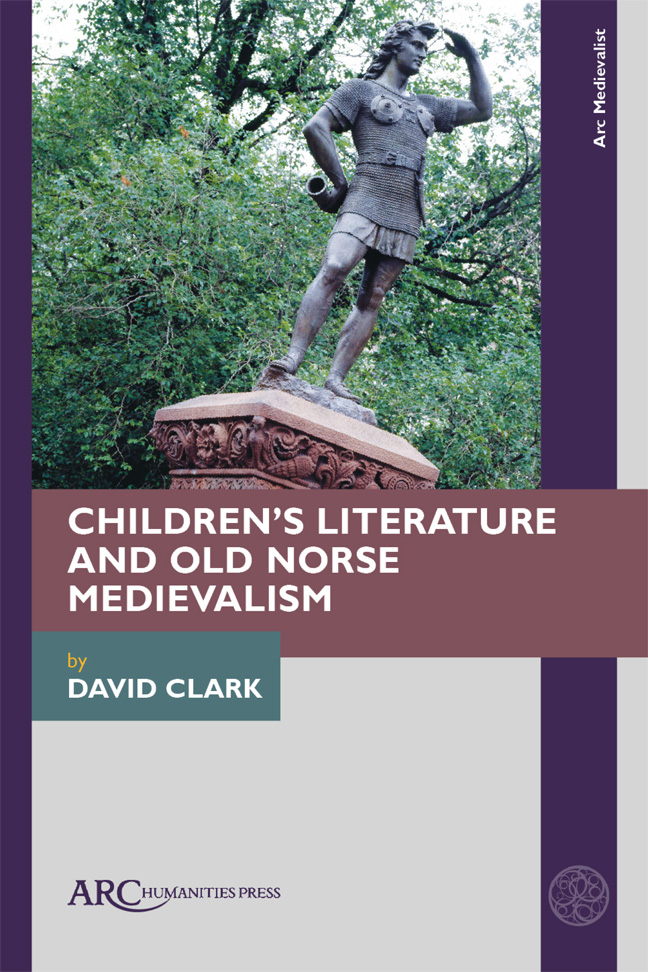Book contents
- Frontmatter
- Contents
- Acknowledgements
- Dedication
- Introduction: The End
- 1 Age-Related Categories
- 2 Generic Categories
- 3 Transformational Fantasy
- 4 Horned Helmets and Comic Anachronism
- 5 Viking Reputation
- 6 Runes and Magic
- 7 The Power of Story
- 8 Race and Ethnicity
- 9 Heroism
- 10 Viking Masculinity
- 11 Viking Femininity
- 12 Viking Sex and Gender
- 13 Bowdlerization
- 14 Sexuality
- 15 Ecological Threat
- 16 Norse Medievalism in Alan Early's Father of Lies Trilogy
- 17 Avoiding the End of Days: K. L. Armstrong and M. A. Marr's Blackwell Pages
- 18 Rick Riordan's Magnus Chase Series and Norse Medievalism
- Conclusion
- Select Bibliography of Frequently Cited Works
- Index
Introduction: The End
Published online by Cambridge University Press: 17 February 2024
- Frontmatter
- Contents
- Acknowledgements
- Dedication
- Introduction: The End
- 1 Age-Related Categories
- 2 Generic Categories
- 3 Transformational Fantasy
- 4 Horned Helmets and Comic Anachronism
- 5 Viking Reputation
- 6 Runes and Magic
- 7 The Power of Story
- 8 Race and Ethnicity
- 9 Heroism
- 10 Viking Masculinity
- 11 Viking Femininity
- 12 Viking Sex and Gender
- 13 Bowdlerization
- 14 Sexuality
- 15 Ecological Threat
- 16 Norse Medievalism in Alan Early's Father of Lies Trilogy
- 17 Avoiding the End of Days: K. L. Armstrong and M. A. Marr's Blackwell Pages
- 18 Rick Riordan's Magnus Chase Series and Norse Medievalism
- Conclusion
- Select Bibliography of Frequently Cited Works
- Index
Summary
“Seven o’clock on a Monday morning, five hundred years after the End of the World, and goblins had been at the cellar again.”
(Joanne Harris, Runemarks)“It says the end of the world…again.”
(Alan Early, Arthur Quinn and the World Serpent)THESE TWO QUOTATIONS encapsulate the essentially recursive nature of much medievalist fiction. Ragnarok, the end of the world, marks the culmination of Norse history—prophesied by a mysterious seeress in the opening poem of the Poetic Edda. In these twenty-first century Young Adult/ children's novels, it has happened long ago—and may happen again. And again. The authors symbolically acknowledge their ancient sources and at the same time distance themselves from them—they are not “medieval” but “medievalist”—their looming cataclysms are new Ragnaroks for a new generation.1 They provide a source of challenge for their adolescent protagonists—a disaster to avert, a trial to overcome—and in doing so help their adolescent readers negotiate the issue of their own agency in an adult world. They link past to present; find ways to make alien cultural content familiar and relevant; immerse readers in their reimagined medieval worlds. Norse mythology and history becomes a source of inspiration, a jumping-off point for contemporary writers to make older content new, to adapt it for the needs of a fresh generation. And yet.
And yet the prophecy of the seeress does not end with Ragnarok—the fateful encounter between the gods of Asgard and the forces of destruction led by Loki's monstrous children. After the Fimbulwinter; after the wolf Fenrir swallows Odin whole and is slain in turn by the god's son; after Thor defeats the Midgard Serpent then suc-cumbs to its poison; after Loki and Heimdall are each other's deaths; after Surt engulfs the world in flame…then a new world will come. The earth will reappear from the sea and the sun will be reborn; a younger generation of gods will rise and the human race will repopulate itself; Balder will return from Hel and live with the brother who killed him. Contemporary versions of Ragnarok merely continue this process of rebirth and renewal, reimagining the Norse myths but also recognizing their pre-existence as sources. And yet.
And yet this account of the Norse Ragnarok is itself a retelling, a reimagining.
- Type
- Chapter
- Information
- Children's Literature and Old Norse Medievalism , pp. 1 - 16Publisher: Amsterdam University PressPrint publication year: 2023

